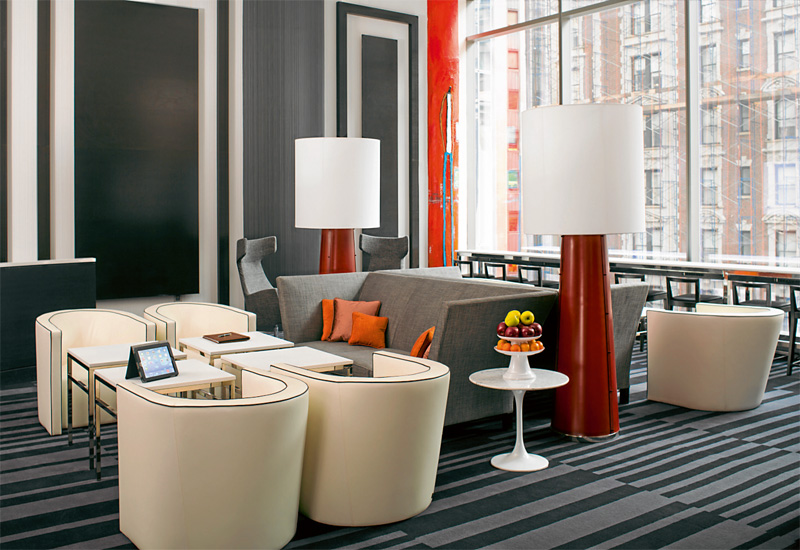“It really gave us the opportunity to think outside the box and to create this unique building and possibility where we have the entire 35th floor as a fitness centre to serve both brands, the fourth floor Courtyard Bistro to serve both brands,” says Gross, who fit as a fiddle himself apparently climbs the entire hotel via the stairs whenever he’s there.
“There’s a lot of synergy in accounting, sales, maintenance in other functions. We have one GM so there’s a lot of savings and by this small footprint, we are contributing in a way to being green — it saves energy and many other things,” he adds.
To build the new Courtyard and Residence Inn Central Park, Gross received the first construction loan in NYC made following the financial crisis of 2008 thanks to a long-standing partnership with Wells Fargo financiers.

| Advertisement |
“It was indeed difficult,” Gross recalls. “After 2008, there was sort of paralysis in the capital markets, no one would lend any money, certainly not for new construction, even refinancing existing properties was difficult. We went to our relationship bank, which is Wells Fargo, with whom we have banked for the last 20-plus years and Tim Sloan, who right now is the CFO, was very helpful,” he continues.
“I remember visiting him and he mentioned something like ‘Harry we have 40 million customers and this is the only and first loan that we have made, and he granted us this loan for $180mn’.”
Gross is clearly a man that makes things happen, although funnily enough, building North America’s tallest hotel was not actually on his agenda. He purchased the site for $32 million back in 2001, when it consisted of just a restaurant, a corner shop and clothing store, and after several years of “struggling to figure out how to build on it”, finally assembled air rights in 2008 and started from the bottom up, appointing Nobutaka Ashihara Associates as the architect.
“We didn’t have any idea what the record would be,” recalls Gross. “We tried to mass the maximum square footage that the 100ft by 100ft site could support. The idea of being the tallest didn’t occur to us until after we finished, it was just whatever we could put on the property,” he admits.
The partnership with DeBilzan, whose sculptures welcome guests in the lobby, was also something that came about by good fortune.
“Like everything else it’s just by chance,” recalls Gross. “I visited my sister-in-law in Florida in Delray Beach and saw this gallery with these iconic figures with long legs so I walked in and spoke with the sales lady there and said ‘I am opening this hotel and I want to buy all of the art here’. I added at 50% of course,” he jokes.
“But there were no takers so I went home and later on that idea was still with me so I called Bill and asked him to come down to New York to talk about this hotel —that’s how I met Bill.”
The result was a 90-day project culminating in six sculptures, nine total pillars of artwork, eight paintings in the elevators and two additional paintings in the lower lobby rooms, inspired by the opportunity and freedom of New York City.
Sculptures of boldly coloured thin, faceless elongated figures catch the eye and the same abstract compositions feature in the rich, textured canvases. The artist claims his work is based on thoughts and memories of real life experiences; for me as a guest, as opposed to art critic I should add, the bold use of colour brightened the environment and added an element of fun to the surroundings.
But I was curious as to how Gross had incorporated the art into the project. After all, such strong international hotel brands are usually bound by fairly rigid brand standards.
“They are not necessarily famous for the art in these hotels but they are famous for many other things, which we think are the most beneficial for us as owners,” says Gross of his decision to flag the hotels under Courtyard and Residence Inn. “We try to bring in some humanity and warmth and spearhead a trend that could catch on. I believe that mixing art with where you work and live is a good idea.”
Surprisingly, Sorenson said Marriott was increasingly open to this and that many owners did seek to get involved with artwork nowadays.
“I think when you look back certainly 15 years ago, we would have said ‘no, we would like this Courtyard in Manhattan to look like all other Courtyards,’” Sorenson says, “and I think today we would say we want it to have a relationship with the way the Courtyard brand works as a whole so people will know that it’s consistent with a Courtyard experience but we actually like it to have some individual flair and if you’ve got an artist you want to work with we would love that because again it leaves an impression with the guest after they’ve left.”
Gross says he wants to start a trend and it’s worth noting that this is the same owner that made Residence Inn by Marriott Times Square the first 100% non-smoking hotel in New York City and in the Marriott chain of hotels — a policy that is now standard across the city.
He’s also just opened the western hemisphere’s tallest hotel amid the coldest temperatures New York’s Central Park has seen for 108 years. I’ve an inkling that if Gross is behind the trend, with the support already of the CEO of one of the world’s greatest hotel companies, it might just catch on.










 Search our database of more than 2,700 industry companies
Search our database of more than 2,700 industry companies









